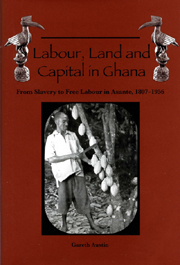Book contents
- Frontmatter
- Contents
- List of Illustrations
- List of Tables
- Preface
- Note on Names
- Maps
- Note on the Maps
- 1 Introduction
- Part I Context and Concepts
- Part II Social Relations of Production and Trade, 1807–1896: Absent and Imperfect Factor Markets
- Part III Slavery as Hobson's Choice: An Analysis of the Interaction of Markets and Coercion in Asante's Era of ‘Legitimate Commerce’, 1807–1896
- 8 Factor Markets Without Free Labour: The Nieboer Hypothesis and Asante Slavery and Pawnship, 1807–1896
- 9 Gender and Kinship Aspects of the Social Relations of Production, 1807–1896
- 10 Exploitation and Welfare: Class and ‘Social Efficiency’ Implications of the Property Rights Regime, 1807–1896
- Part IV The Decline of Coercion in the Factor Markets of Colonial Asante: Cocoa and the Ending of Slavery, Pawnship and Corvée, 1896–c.1950
- Part V Social Relations of Production and Trade, 1908–1956: Towards Integrated Factor Markets?
- Part VI Freedom and Forest Rent, 1908–1956
- Abbreviations Used in the Notes
- Notes
- List of References
- Index
9 - Gender and Kinship Aspects of the Social Relations of Production, 1807–1896
from Part III - Slavery as Hobson's Choice: An Analysis of the Interaction of Markets and Coercion in Asante's Era of ‘Legitimate Commerce’, 1807–1896
Published online by Cambridge University Press: 12 September 2012
- Frontmatter
- Contents
- List of Illustrations
- List of Tables
- Preface
- Note on Names
- Maps
- Note on the Maps
- 1 Introduction
- Part I Context and Concepts
- Part II Social Relations of Production and Trade, 1807–1896: Absent and Imperfect Factor Markets
- Part III Slavery as Hobson's Choice: An Analysis of the Interaction of Markets and Coercion in Asante's Era of ‘Legitimate Commerce’, 1807–1896
- 8 Factor Markets Without Free Labour: The Nieboer Hypothesis and Asante Slavery and Pawnship, 1807–1896
- 9 Gender and Kinship Aspects of the Social Relations of Production, 1807–1896
- 10 Exploitation and Welfare: Class and ‘Social Efficiency’ Implications of the Property Rights Regime, 1807–1896
- Part IV The Decline of Coercion in the Factor Markets of Colonial Asante: Cocoa and the Ending of Slavery, Pawnship and Corvée, 1896–c.1950
- Part V Social Relations of Production and Trade, 1908–1956: Towards Integrated Factor Markets?
- Part VI Freedom and Forest Rent, 1908–1956
- Abbreviations Used in the Notes
- Notes
- List of References
- Index
Summary
The most basic part of the social organization of labour in the nineteenth century was the respective roles of the free members of the same household: this was ‘basic’ in that it applied whether or not they had slaves or pawns in addition. Accordingly, Section A considers the consequences for investment and the accumulation of wealth of the particular division of labour between free spouses that characterized nineteenth-century Asante, and asks why the conjugal family was the basic unit of work in this otherwise predominantly matrilineal setting. Section B examines how slavery and pawning related to men's strategies within the family structures of nineteenth-century Asante society. It discusses the gender dimension of the Asante demand for slaves and pawns and explores the implications of this for the relative importance of the productive and, in a broad sense, the reproductive uses of slaves and pawns.
Gender and Kinship in the Allocation of Household Labour
The discussion here focuses on two key aspects of the ways in which productive resources were channelled by ‘household’ institutions: a characteristic division of labour between the sexes, and the paradox, pointed out by Arhin, that ‘in spite of their matrilineal inheritance system, the Ashanti basic unit of labour in mining, trading and farming has always been the conjugal family’.
We have seen that women were expected to give priority to the activities that enabled the household to survive and reproduce itself, physically and socially. Men, though making certain important contributions to food farming (especially clearing the land), were responsible for the bulk of the extra-subsistence economic activities.
- Type
- Chapter
- Information
- Labour, Land and Capital in GhanaFrom Slavery to Free Labour in Asante, 1807–1956, pp. 171 - 180Publisher: Boydell & BrewerPrint publication year: 2005

